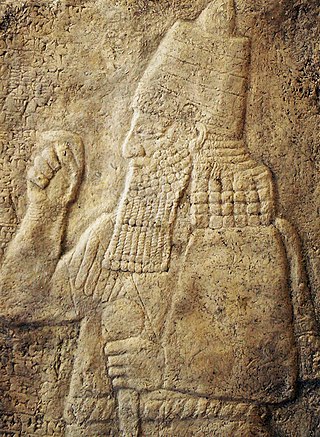
Sennacherib was the king of the Neo-Assyrian Empire from the death of his father Sargon II in 705 BC to his own death in 681 BC. The second king of the Sargonid dynasty, Sennacherib is one of the most famous Assyrian kings for the role he plays in the Hebrew Bible, which describes his campaign in the Levant. Other events of his reign include his destruction of the city of Babylon in 689 BC and his renovation and expansion of the last great Assyrian capital, Nineveh.

Babylonia was an ancient Akkadian-speaking state and cultural area based in the city of Babylon in central-southern Mesopotamia. It emerged as an Akkadian populated but Amorite-ruled state c. 1894 BC. During the reign of Hammurabi and afterwards, Babylonia was retrospectively called "the country of Akkad", a deliberate archaism in reference to the previous glory of the Akkadian Empire. It was often involved in rivalry with the older ethno-linguistically related state of Assyria in the north of Mesopotamia and Elam to the east in Ancient Iran. Babylonia briefly became the major power in the region after Hammurabi created a short-lived empire, succeeding the earlier Akkadian Empire, Third Dynasty of Ur, and Old Assyrian Empire. The Babylonian Empire rapidly fell apart after the death of Hammurabi and reverted to a small kingdom centered around the city of Babylon.

Myrrha, also known as Smyrna, is the mother of Adonis in Greek mythology. She was transformed into a myrrh tree after having intercourse with her father, and gave birth to Adonis in tree form. Although the tale of Adonis has Semitic roots, it is uncertain where the myth of Myrrha emerged from, though it was probably from Cyprus.

Ninus, according to Greek historians writing in the Hellenistic period and later, was the founder of Nineveh, ancient capital of Assyria. The figure or figures with which he corresponds in Assyrian records is uncertain; an association or identification with Ninurta has been proposed. An identification with Shamshi-Adad I, Shamshi-Adad V, and/or a conflation of the two have also been suggested.
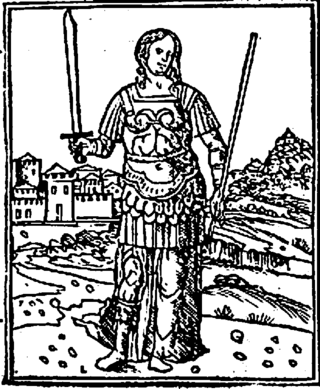
Semiramis was the legendary Lydian-Babylonian wife of Onnes and of Ninus, who succeeded the latter on the throne of Assyria, according to Movses Khorenatsi. Legends narrated by Diodorus Siculus, who drew primarily from the works of Ctesias of Cnidus, describe her and her relationships to Onnes and King Ninus.
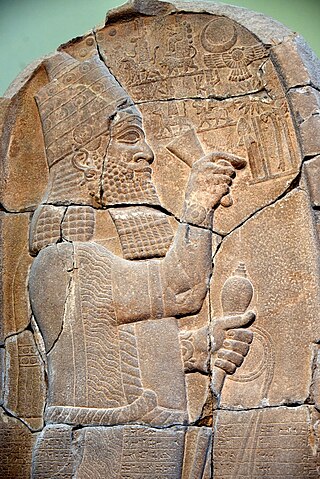
Esarhaddon, also spelled Essarhaddon, Assarhaddon and Ashurhaddon was the king of the Neo-Assyrian Empire from the death of his father Sennacherib in 681 BC to his own death in 669. The third king of the Sargonid dynasty, Esarhaddon is most famous for his conquest of Egypt in 671 BC, which made his empire the largest the world had ever seen, and for his reconstruction of Babylon, which had been destroyed by his father.
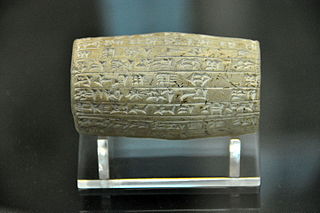
Nabopolassar was the founder and first king of the Neo-Babylonian Empire, ruling from his coronation as king of Babylon in 626 BC to his death in 605 BC. Though initially only aimed at restoring and securing the independence of Babylonia, Nabopolassar's uprising against the Neo-Assyrian Empire, which had ruled Babylonia for more than a century, eventually led to the complete destruction of the Assyrian Empire and the rise of the Neo-Babylonian Empire in its place.

Ashurbanipal was the king of the Neo-Assyrian Empire from 669 BC to his death in 631. He is generally remembered as the last great king of Assyria. Ashurbanipal inherited the throne as the favored heir of his father Esarhaddon; his 38-year reign was among the longest of any Assyrian king. Though sometimes regarded as the apogee of ancient Assyria, his reign also marked the last time Assyrian armies waged war throughout the ancient Near East and the beginning of the end of Assyrian dominion over the region.
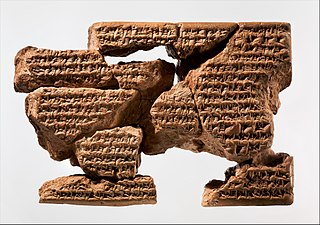
Sîn-šar-iškun was the penultimate king of Assyria, reigning from the death of his brother and predecessor Aššur-etil-ilāni in 627 BC to his own death at the Fall of Nineveh in 612 BC.

Šamaš-šuma-ukin, was king of Babylon as a vassal of the Neo-Assyrian Empire from 668 BC to his death in 648. Born into the Assyrian royal family, Šamaš-šuma-ukin was the son of the Neo-Assyrian king Esarhaddon and the elder brother of Esarhaddon's successor Ashurbanipal.

Sardanapalus was, according to the Greek writer Ctesias, the last king of Assyria, although in fact Aššur-uballiṭ II holds that distinction.
The Battle of Nineveh is conventionally dated between 613 and 611 BC, with 612 BC being the most supported date. Rebelling against the Assyrians, an allied army which combined the forces of Medes and the Babylonians besieged Nineveh and sacked 750 hectares of what was, at that time, one of the greatest cities in the world. The fall of Nineveh led to the destruction of the Neo-Assyrian Empire over the next three years as the dominant state in the Ancient Near East. Archeological records show that the capital of the once mighty Assyrian Empire was extensively de-urbanized and depopulated in the decades and centuries following the battle. A garbled account of the fall of the city later led to the story of the legendary king Sardanapalus.

Ercole contro i tiranni di Babilonia is a 1964 Italian sword-and-sandal film directed by Domenico Paolella and starring Peter Lupus.

Sardanapalo or Sardanapale, S.687, is an unfinished opera by Franz Liszt based on the 1821 verse play Sardanapalus by Lord Byron. Liszt was ambitious for his project, and planned to dovetail his retirement as a virtuoso with the premiere of his opera. He worked on it intermittently between 1845 and 1852, once declaring it 'well on the way toward completion,' but ceased work on it thereafter. The first act had been completed in a detailed, continuous particell, but there is no evidence of any music being notated for Acts 2–3. As an Italian opera, it would almost certainly have been called Sardanapalo, though Liszt referred to it as Sardanapale in his French correspondence. The music Liszt completed remained silent until 2016 when British musicologist David Trippett first established the legibility of Liszt's N4 manuscript, and produced both a critical edition and realized an orchestral performing edition. This received its world premiere in Weimar on 19 August 2018.

Io Semiramide is a 1963 Italian peplum film about Semiramis, a queen of the Neo-Assyrian Empire. It was directed by Primo Zeglio. The legends are in part based on the historical Shammuramat, queen consort of Shamshi-Adad V and regent for her son Adad-nirari III.

The Queen of Babylon is a 1954 Italian peplum film set in the Neo-Babylonian Empire in the year 600 BC.

Enlil-nādin-aḫe, “Enlil gives a brother,” or Enlil-šuma-uṣur, “Enlil protect the son,” depending on the reading of –MU-ŠEŠ, ca. 1157—1155 BC, was the 36th and final king of the Kassite or 3rd dynasty that had ruled over Babylon and the land known as Karduniash since perhaps around 1500 BC.

Sardanapalus (1821) is a historical tragedy in blank verse by Lord Byron, set in ancient Nineveh and recounting the fall of the Assyrian monarchy and its supposed last king. It draws its story mainly from the Historical Library of Diodorus Siculus and from William Mitford's History of Greece. Byron wrote the play during his stay in Ravenna, and dedicated it to Goethe. It has had an extensive influence on European culture, inspiring a painting by Delacroix and musical works by Berlioz, Liszt and Ravel, among others.

The Sargonid dynasty was the final ruling dynasty of Assyria, ruling as kings of Assyria during the Neo-Assyrian Empire for just over a century from the ascent of Sargon II in 722 BC to the fall of Assyria in 609 BC. Although Assyria would ultimately fall during their rule, the Sargonid dynasty ruled the country during the apex of its power and Sargon II's three immediate successors Sennacherib, Esarhaddon and Ashurbanipal are generally regarded as three of the greatest Assyrian monarchs. Though the dynasty encompasses seven Assyrian kings, two vassal kings in Babylonia and numerous princes and princesses, the term Sargonids is sometimes used solely for Sennacherib, Esarhaddon and Ashurbanipal.

Akkadian or Mesopotamian royal titulary refers to the royal titles and epithets assumed by monarchs in Ancient Mesopotamia from the Akkadian period to the fall of the Neo-Babylonian Empire, with some scant usage in the later Achaemenid and Seleucid periods. The titles and the order they were presented in varied from king to king, with similarities between kings usually being because of a king's explicit choice to align himself with a predecessor. Some titles, like the Akkadian šar kibrāt erbetti and šar kiššatim and the Neo-Sumerian šar māt Šumeri u Akkadi would remain in use for more than a thousand years through several different empires and others were only used by a single king.



















